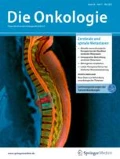Zusammenfassung
In den letzten 10 Jahren verbesserten sich die tele- und die brachytherapeutische Strahlentherapie durch die Entwicklung und Implementierung neuer moderner Bestrahlungsgeräte, 3D-Bestrahlungsplanungsprogramme, moderner Fixationsmethoden, die Integration moderner bildgebender Verfahren [Mehrzeilen-CT (CT: Computertomographie), MRT (Magnetresonanztomographie)] sowie funktioneller Bildgebung [PET-CT (PET: Positronenemissionstomographie)] in den Planungsprozess deutlich. Die Definition des Tumorzielvolumens und der Risikoorgane können dadurch exakter durchgeführt und eine patientenspezifische Gestaltung der Dosisverteilung mit selektiver Schonung von Risikoorganen erstellt werden. Ziel einer modernen Strahlentherapie ist, die lokale Tumorkontrolle zu erhalten oder zu verbessern und dabei die Nebenwirkungsrate zu senken. Die Art der Bestrahlung sowie die hierfür notwendigen Energien werden individuell festgelegt. 90% der teletherapeutischen Bestrahlungen werden mit hochenergetischen Röntgen- bzw. Photonenstrahlen durchgeführt. Daneben werden in jüngster Zeit auch Protonen und Schwerionen verwendet. Aktuell wird geprüft, ob sich mit den neuen Methoden Verbesserungen der Behandlungsergebnisse erzielen lassen.
Abstract
Over the last decade, external beam therapy and brachytherapy have significantly improved due to the development and the implementation of modern treatment devices, 3-D conformal treatment planning software, rigid immobilization, modern multiple slice computed imaging modalities (computed tomography, magnetic resonance imaging) and functional imaging (positron emission tomography) in the planning process. The definition of target volumes and organs at risk has become more precise and individual configuration of dose plans as selective sparing of organs at risk has been achieved. The primary aim of modern radiation oncology is to preserve or even improve local tumor control while reducing the risk for treatment side-effects. The treatment modality and energy are individually chosen for each patient. More than 90% of patients are treated with high energy x-rays or photons. Recently, proton and heavy ion beam therapy have been introduced, however, clinical superiority has still to be proven.



Literatur
Beltran C, Naik M, Merchant TE (2010) Dosimetric effect of target expansion and setup uncertainty during radiation therapy in pediatric craniopharyngioma. Radiother Oncol 97:399–403
Gragoudas ES, Marie Lane A (2005) Uveal melanoma: proton beam irradiation. Ophthalmol Clin North Am 18(1):111–118
Habrand JL, Schneider R, Alapetite C et al (2008) Proton therapy in pediatric skull base and cervical canal low-grade bone malignancies. Int J Radiat Oncol Biol Phys 71(3):672–675
MacDonald SM, Safai S, Trofimov A et al (2008) Proton radiotherapy for childhood ependymoma: initial clinical outcomes and dose comparisons. Int J Radiat Oncol Biol Phys 71(4):979–986
Mansur DB, Klein EE, Maserang BP (2007) Measured peripheral dose in pediatric radiation therapy: a comparison of intensity-modulated and conformal techniques. Radiother Oncol 82:179–184
McAllister B, Archambeau JO, Nguyen MC et al (1997) Proton therapy for pediatric cranial tumors: preliminary report on treatment and disease-related morbidities. Int J Radiat Oncol Biol Phys 39(2):455–460
Munzenrider JE, Liebsch NJ (1999) Proton therapy for tumors of the skull base. Strahlenther Onkol [Suppl 2] 175:57–63
Noel G, Habrand JL, Helfre S et al (2003) Proton beam therapy in the management of central nervous system tumors in childhood: the preliminary experience of the Centre de Protonthérapie d’Orsay. Med Pediatr Oncol 40(5):309–315
Paulino AC, Mazloom A, Teh BS et al (2011) Local control after craniospinal irradiation, intensity-modulated radiotherapy boost, and chemotherapy in childhood medulloblastoma. Cancer 117:635–641
Rutz HP, Weber DC, Goitein G et al (2008) Postoperative spot-scanning proton radiation therapy for chordoma and chondrosarcoma in children and adolescents: initial experience at Paul Scherrer Institute. Int J Radiat Oncol Biol Phys 71(1):220–225
Schneider U, Lomax A, Timmermann B (2008) Second cancers in children treated with modern radiotherapy techniques. Radiother Oncol 89:135–140
Shaffer R, Vollans E, Vellani R et al (2011) A radiotherapy planning study of RapidArc, intensity modulated radiotherapy, three-dimensional conformal radiotherapy, and parallel opposed beams in the treatment of pediatric retroperitoneal tumors. Pediatr Blood Cancer 56:16–23
Sharma DS, Gupta T, Jalali Ret al (2009) High-precision radiotherapy for craniospinal irradiation: evaluation of three-dimensional conformal radiotherapy, intensity-modulated radiation therapy and helical tomotherapy. Br J Radiol 82:1000–1009
Sterzing F, Stoiber EM, Nill S et al (2009) Intensity modulated radiotherapy (IMRT) in the treatment of children and adolescents – a single institution’s experience and a review of the literature. Radiat Oncol 4:37
Timmermann B, Schuck A, Niggli F et al (2007) Spot-scanning proton therapy for malignant soft tissue tumors in childhood: first experiences at the Paul Scherrer Institute. Int J Radiat Oncol Biol Phys 67:497–504
Wilson RR (1946) Radiological use of fast protons. Radiology 47(5):487–491
Interessenkonflikt
Die korrespondierende Autorin gibt an, dass kein Interessenkonflikt besteht
Author information
Authors and Affiliations
Corresponding author
Rights and permissions
About this article
Cite this article
Dieckmann, K., Timmermann, B. Innovative Techniken und Partikeltherapie . Onkologe 17, 1005–1012 (2011). https://doi.org/10.1007/s00761-011-2161-2
Published:
Issue Date:
DOI: https://doi.org/10.1007/s00761-011-2161-2

